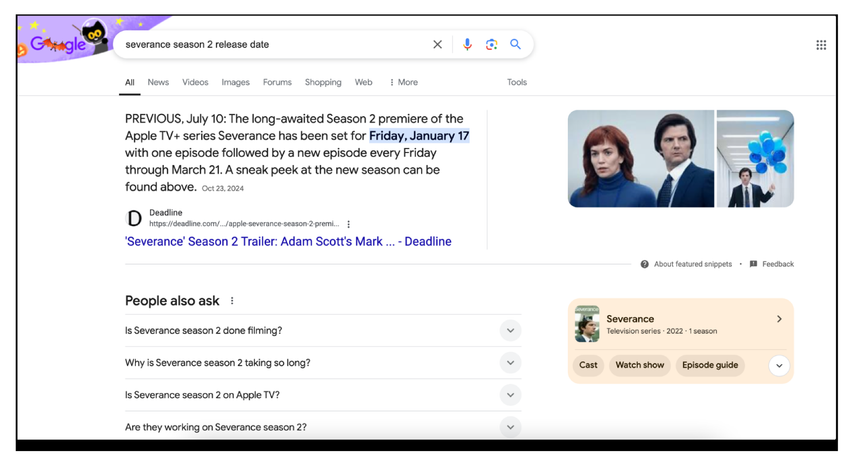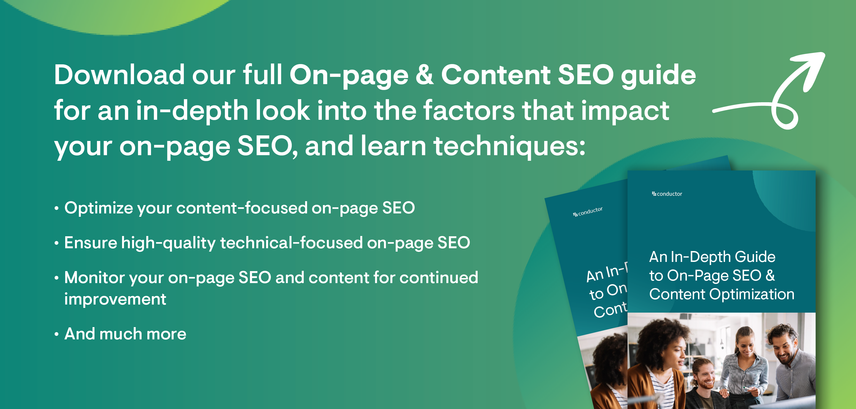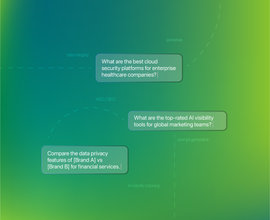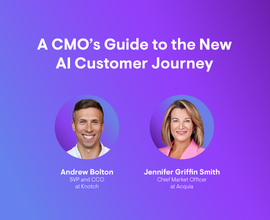An In-Depth Guide to On-Page SEO & Content Optimization
On-page SEO and content optimization are the continuous processes of improving everything within your direct control of a webpage to maximize its search performance and user experience. From content quality to technical elements like Schema markup, these factors directly impact how your pages rank on search engines and how users interact with your content.
Dive into strategies to optimize your on-page SEO and content to drive stronger organic performance and deliver better user experiences.
On-page SEO and content optimization are the processes of improving the content—and some technical—aspects of your site to create better UX and increase your visibility through organic search.
What is on-page SEO?
On the surface, this may sound like the process of creating helpful and authoritative content. And that is a big part of on-page SEO, but it’s not everything. On-page SEO also encompasses smaller content considerations like meta descriptions, title tags, and some technical factors.
So, where does on-page SEO stop?
On-page SEO vs. off-page SEO
On-page SEO refers to everything within your direct control when optimizing a page. This means any aspect of the page that you or your team can edit on your own. This includes the content on the page and how helpful, high-quality, and authoritative it is. But it also includes internal and external links, along with technical elements like Schema, metadata, and more.
On the other hand, off-page SEO refers to anything that’s out of your control when you’re optimizing a page that still impacts your site’s search performance. A good example is backlinksBacklinks
Backlinks are links from outside domains that point to pages on your domain; essentially linking back from their domain to yours.
Learn more, as you don’t have full control over whether another site links to your content.
Why is on-page SEO important?
On-page SEO is important because it affects how search engines and users view and interact with your website. On-page SEO is all about meeting user intent for keywords and providing high-quality content to satisfy that need. If your content, heading structure, metadata, and links are strong, then that sends positive signals to Google.
On-page SEO also impacts user experienceUser Experience
User experience (or UX for short) is a term used to describe the experience a user has with a product.
Learn more. If users visit your site and get the answers they need, they’re more likely to return for future inquiries and share your site with friends and colleagues.
However, if aspects of your on-page SEO are poor and your content doesn’t satisfy user needs, your site will not rank well and won’t drive traffic.
On-page SEO for content
The content on a given web page is the bulk of what on-page SEO refers to, so we’ll start here.
The following strategies are a great starting point for optimizing your on-page content but keep in mind that it’s not an exhaustive list of every factor that can impact your on-page SEO. Find more on-page elements to optimize for in the downloadable guide.

Create SEO-friendly URLs
The URL you choose impacts a page's performance from both a search and user experience perspective. Google often displays a page's URL as breadcrumbs, giving users another clue as to whether your page is relevant to their needs, so from Google’s perspective, short and descriptive URLs are best for improving rankingsRankings
Rankings in SEO refers to a website’s position in the search engine results page.
Learn more and driving traffic.
Take our Beginner’s Guide to Website Optimization as an example. The URL /academy/website-optimization/ makes it clear what content the page covers (website optimization) and where users and search engines can find it on the site (in the Academy). This makes it easy for search engines to find and index the page, and makes it easy for users to navigate to it.
Maximize your meta information
Your meta information—AKA metadata—includes a page’s title tag and meta description, both of which appear on SERPs. It’s another way for you to inform users on what your content covers and what questions it will answer. The more descriptive and succinct your meta information is, the easier it will be for users to find the answers they need, and the more likely your content is to rank well on search engines.
Create strong, well-structured headings
Your headings should help users understand what information they’ll get in each section of your content and which information is most important. For instance, in this article, if you scroll to the section Why is on-page SEO important? you immediately know what the section is about and whether it answers your question.
Optimize your page content
Your page content is arguably the most important aspect of on-page SEO. The content on your pages is what answers users' questions when they search on Google, so your content needs to be high-quality, helpful, and relevant to your audience’s needs to drive traffic.
But the words on the page aren’t the only things that come into play with your page content. For example, the following factors all ladder up to making your page content as strong as possible.
- Content quality & readability: AKA the words on the page. Your content needs to be helpful and authoritative to rank well and drive traffic. But you can have fantastic content and still struggle to outrank competitors on SERPs. Your content needs to be strong and provide a unique perspective that users can’t find elsewhere. Google’s acronym, E-E-A-T , is a good rule of thumb for creating effective and helpful content, but more on that later.
- Content topics: If you can learn what topics your audience is searching for, you can answer the questions they have, anticipate their needs, and thoughtfully employ keywords to create a coherent and helpful piece. Just adding keywords to add them—AKA keyword stuffing—will make your article read more awkwardly and less authoritatively. Keyword stuffing isn’t helpful to users and will lead to poor rankings, reduced traffic, and low engagement.
- Images: Google extracts information about the image's subject matter from the page content, including captions, image titles, and image alt tags. So, using clear, concise, and descriptive image titles, alt tags, and file names makes it easier for Google to extract that information and provide it to users. This also improves accessibility, increasing the number of people who can engage with the content. That improves the user experience and sends a positive signal to Google.
- Links: Links are central to building helpful and authoritative content. By weaving relevant links into your content, you strengthen the product by anticipating user needs and directing them to content that can answer further questions. This also makes it easier for users to navigate your website and find the answers they need without returning to the homepage and starting their search over again. Plus, linking to high-quality, authoritative content outside of your site signals to Google that your site is reputable, and the information on it can be trusted because you’re linking to a site Google already trusts.
To sum up, your page content has significant implications for your on-page SEO efforts. The more helpful, relevant, and unique your content, images, links, and content strategy are, the more likely you are to secure high rankings on SERPs and increase quality, intent-driven traffic.
Target featured snippets
Featured snippets are highlighted excerpts of text that appear at the top of a Google search results page to provide users with a quick answer to their search query.

Since featured snippetsFeatured Snippets
A featured snippet is a special search result appearing at the top of Google results, displaying direct answers extracted from web pages.
Learn more own the top spot on SERPs in position zero, the potential for improved traffic is significant if you can capture the snippet, and the snippet is based largely on the strength of your on-page SEO elements, especially page content.
Keep E-E-A-T in mind
E-E-A-T stands for Experience, Expertise, Authoritativeness, and Trustworthiness. E-E-A-T has a lot to do with your page content. The more experience, expertise, and authority your content shows, the more trust users and search engines will have that your content is accurate.
Ultimately, the quality of your content is inherently tied to the experience, expertise, authority, and trustworthiness of your website. Focus on E-E-A-T and providing positive user experiences, and strong traffic, engagement, and conversions will follow.

On-page SEO for technical health
Not all on-page SEO has to do with your content. There are a fair amount of factors within the technical side of your pages that you do have direct control over when it comes to SEO. Specifically, the following technical factors really move the needle when it comes to optimizing your website experience for visitors.
Leverage Schema markup
Schema markup helps search engines better understand the information on your page by adding specific code to communicate that specific information to search engines and target rich result types—for example, a product review, recipe details, or event information. By leveraging Schema markupSchema Markup
Schema markup is structured data added to web pages that tells search engines what content means, enabling rich results and enhanced search features.
Learn more, you can provide users and Google with helpful information about your content without them needing to click on your page.
Optimize your UX
A lot goes into user experience (UX). Anything from choosing a readable font to the placement of your homepageHomepage
A homepage is a collection of HTML documents that can be called up as individual webpages via one URL on the web with a client such as a browser.
Learn more button affects user experience. But looking under the hood and making sure that your website and pages load and operate smoothly, quickly, and correctly is critical to ensuring that your users value and trust your content.
Google weighs user experience and wants to provide as helpful and seamless an experience as possible. Content with strong UX will rank higher and drive more relevant organic traffic than content with poor UX.
A key UX element is page speed. How quickly your site loads and operates is key to both user experience and winning top search engineSearch Engine
A search engine is a website through which users can search internet content.
Learn more rankings. You’ve likely used a slow website in the past. It’s frustrating, and you’ll most likely exit that page to find another top-ranking article with faster loading times. Google understands this, too, and uses page speed and other Core Web Vitals as ranking factors for SERPs.

How to monitor your on-page SEO
Like any other aspect of your website, you need to keep an eye on your on-page SEO and content to maximize performance. But doing so is much easier said than done. However, there are several helpful tools that track your on-page SEO and provide you with the next steps to improve it.
The Conductor Chrome extension is a great (and free) starting place for ensuring that your on-page SEO is strong from a content perspective.
In addition, Conductor Website Monitoring keeps track of each page of your website 24/7 and instantly informs you of any issues that arise or changes that are made. 24/7 monitoring ensures that every corner of your site is being tracked to remove the guesswork from resolving technical issues.
On-page SEO & content optimization in review
To summarize, on-page SEO and content optimization are critical aspects of maximizing your website’s ability to drive traffic, engagement, and conversions. They also impact user experience and how Google views and ranks your website.
You need to continuously monitor your website to ensure your on-page SEO and content are strong and act deliberately to optimize poor-performing content. When anything from page content to URLs, to external links, to Schema can impact your rankings and traffic, you can’t afford to wait to optimize your content and on-page SEO.








